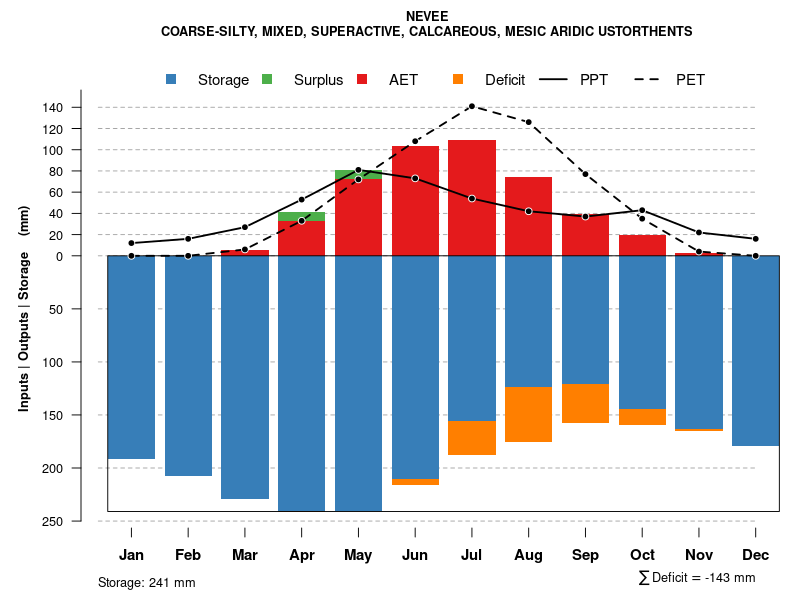| Nevee silt loam, 2 to 6 percent slopes | P246B | 942 | 2668881 | 2rvdz | sd019 | 1970 | 1:24000 |
Nevee-Spearfish silt loams, 6 to 20 percent slopes | P256D | 796 | 2768094 | 2rvf5 | sd019 | 1970 | 1:24000 |
Nevee silt loam, 6 to 10 percent slopes | P246C | 1 | 2768093 | 2rvf0 | sd019 | 1970 | 1:24000 |
Nevee silt loam, dry, 6 to 15 percent slopes | P250D | 1413 | 2733138 | 2rvf2 | sd047 | 1980 | 1:24000 |
Spearfish-Nevee silt loams, dry, 9 to 30 percent slopes | P476E | 65 | 2768107 | 2rxsg | sd047 | 1980 | 1:24000 |
Nevee-Spearfish silt loams, 6 to 20 percent slopes | P256D | 3741 | 2733259 | 2rvf5 | sd081 | 2007 | 1:24000 |
Nevee-Tilford silt loams, 3 to 10 percent slopes | P262C | 3708 | 2733261 | 2rvf7 | sd081 | 2007 | 1:24000 |
Nevee silt loam, 2 to 6 percent slopes | P246B | 2334 | 2733256 | 2rvdz | sd081 | 2007 | 1:24000 |
Nevee silt loam, 6 to 10 percent slopes | P246C | 2188 | 2733257 | 2rvf0 | sd081 | 2007 | 1:24000 |
Nevee-Spearfish silt loams, very stony, 10 to 40 percent slopes | P258E | 1963 | 2733260 | 2rvf6 | sd081 | 2007 | 1:24000 |
Nevee-Nihill, moderately deep complex, 10 to 50 percent slopes | P254F | 1427 | 2733258 | 2rvf4 | sd081 | 2007 | 1:24000 |
Tilford-Nevee silt loams, 1 to 4 percent slopes | P520B | 1356 | 2733276 | 2s02h | sd081 | 2007 | 1:24000 |
Barnum, moist, occasionally flooded-Tilford-Nevee silt loams, 1 to 25 percent slopes | P032E | 1054 | 2733290 | 2qt21 | sd081 | 2007 | 1:24000 |
Spearfish-Nevee-Gullied land complex, 6 to 30 percent slopes | P478E | 691 | 2733269 | 2rxvr | sd081 | 2007 | 1:24000 |
Nevee-Spearfish silt loams, 6 to 20 percent slopes | P256D | 3367 | 2733428 | 2rvf5 | sd600 | 1974 | 1:24000 |
Nevee-Spearfish complex, 6 to 15 percent slopes | NaD | 100 | 354332 | cwq2 | sd600 | 1974 | 1:24000 |
Nevee-Tilford silt loams, 3 to 10 percent slopes | P262C | 35 | 2768116 | 2rvf7 | sd600 | 1974 | 1:24000 |
Nevee silt loam, dry, 2 to 9 percent slopes | P250C | 8839 | 2745669 | 2rvf1 | sd607 | 2011 | 1:24000 |
Nevee, dry-Gullied land complex, 6 to 40 percent slopes | P252E | 4801 | 2745670 | 2rvf3 | sd607 | 2011 | 1:24000 |
Spearfish-Nevee silt loams, dry, 9 to 30 percent slopes | P476E | 2223 | 2745692 | 2rxsg | sd607 | 2011 | 1:24000 |
Nevee-Spearfish silt loams, 6 to 20 percent slopes | P256D | 1405 | 2768140 | 2rvf5 | sd607 | 2011 | 1:24000 |
Nevee channery loam, dry, 6 to 15 percent slopes | P244D | 1136 | 2745668 | 2rvdy | sd607 | 2011 | 1:24000 |
Nevee silt loam, 2 to 6 percent slopes | P246B | 234 | 2768137 | 2rvdz | sd607 | 2011 | 1:24000 |
Nevee silt loam, 6 to 10 percent slopes | P246C | 207 | 2768138 | 2rvf0 | sd607 | 2011 | 1:24000 |
Nevee-Nihill, moderately deep complex, 10 to 50 percent slopes | P254F | 61 | 2768139 | 2rvf4 | sd607 | 2011 | 1:24000 |
Nevee silt loam, 6 to 10 percent slopes, eroded | P248C | 14853 | 2745769 | 2rvdm | wy011 | 1978 | 1:24000 |
Nevee silt loam, 6 to 10 percent slopes | P246C | 5005 | 2745768 | 2rvf0 | wy011 | 1978 | 1:24000 |
Nevee silt loam, 10 to 30 percent slopes, eroded | P248E | 3770 | 2745771 | 2rvdn | wy011 | 1978 | 1:24000 |
Nevee silt loam, 1 to 6 percent slopes, eroded | P248B | 3103 | 2745767 | 2rvdl | wy011 | 1978 | 1:24000 |
Spearfish-Nevee-Gullied land complex, 6 to 30 percent slopes | P478E | 2920 | 2745737 | 2rxvr | wy011 | 1978 | 1:24000 |
Nevee silt loam, 2 to 6 percent slopes | P246B | 2102 | 2745766 | 2rvdz | wy011 | 1978 | 1:24000 |
Nevee-Spearfish-Barnum, channeled, flooded complex, 2 to 40 percent slopes | P260E | 1697 | 2745736 | 2rvf9 | wy011 | 1978 | 1:24000 |
Nevee silt loam, 10 to 15 percent slopes | P246D | 1162 | 2745770 | 2rxs5 | wy011 | 1978 | 1:24000 |
Nevee-Tilford silt loams, 3 to 10 percent slopes | P262C | 107 | 2745950 | 2rvf7 | wy011 | 1978 | 1:24000 |
Nevee-Spearfish silt loams, 6 to 20 percent slopes | P256D | 54 | 2745948 | 2rvf5 | wy011 | 1978 | 1:24000 |
Tilford-Nevee silt loams, 1 to 4 percent slopes | P520B | 42 | 2745952 | 2s02h | wy011 | 1978 | 1:24000 |
Nevee-Spearfish silt loams, very stony, 10 to 40 percent slopes | P258E | 31 | 2745949 | 2rvf6 | wy011 | 1978 | 1:24000 |
Nevee-Spearfish-Barnum, channeled, flooded complex, 2 to 40 percent slopes | P260E | 300 | 2745981 | 2rvf9 | wy045 | 1984 | 1:24000 |
Nevee silt loam, dry, 2 to 9 percent slopes | P250C | 2 | 2768197 | 2rvf1 | wy045 | 1984 | 1:24000 |














